After an eye-opening first day full of beastly robots, pendulums, and conversations about the future of engineering education, Professor Zhu and Professor Kaiser were the highlights of our second and third days at the ASEE conference with their presentations on their new curricula. Professor Zhu opened the festivities to introduce a groundbreaking course that teaches embedded systems with our STEVAL-DRONE01 drone kit, our first ready-to-use aircraft embarking the STEVAL-FCU001V1 flight controller. Professor Kaiser then took over to talk about a transformative hands-on approach to motor control education during day two, while tackling the extension of the SensorTile curriculum to cover machine learning applications on the last day of the event.
Pictures show an attendance exceeding our expectations and the audience engaged in thoughtful conversations around the three curricula. It was also grandiose to see Xu Zhang, Professor Kaiser’s Assistant, talk about his contributions to the various projects, the source code he wrote, his role in training students, thus showcasing the profound impact an inspiring curriculum in engineering can have on the next generation of innovators. As the doors of ASEE 2019 closed on Tampa, Florida, we were proudly humbled by the overwhelmingly positive feedback we received. Thanks to the labor of love from the professors, their assistants, and all of the ST employees working on our pedagogical initiatives, engineering education is even more ingrained in our corporate social responsibility DNA, the fruits from these innovative curricula grow a little bigger, and we are now reaping a new generation of passionate makers, developers, and problem solvers.
Professor Zhu on the Drone Curriculum
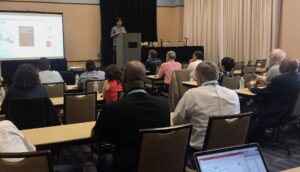
Professor Zhu started his presentation with an overview of his textbook on Arm architectures in Assembly to inform his audience of what he was trying to achieve. Indeed, even if his curriculum on embedded systems with the ST drone kit is different, it still carries the same spirit that drives him to teach his undergraduates the low-level inner workings of microcontrollers and motor controls. As he declared during his talk:
“I’m not training students to use a library, I’m training them to write a library.”One aspect that got a lot of positive reactions was the fact that each lab is independent, meaning that if students struggle with a particular module, they don’t have to carry their burden throughout the rest of the course. The labs are also malleable to tailor the degree of difficulty and the depth of the coursework.
The Audience on the Drone Curriculum
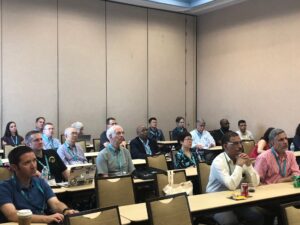
After his talk, a member of the audience expressed enthusiasm at the idea that the curriculum uses a control system that takes in quaternions (four scalar numbers) and converts them into Euler angles. Students always have a hard time with these concepts, and using a drone is a convenient way to visualize how they can apply them to control its movements. The fact that the kit is so affordable was also a topic of discussion. It’s important to note that there is no ST-LINK programmer/debugger on the drone kit. Nevertheless, educators learned that they could perform breakpoint debugging by either acquiring one of our standalone ST-LINK or use the one present on a Nucleo board, thus ensuring that the entire solution is still cheaper than a regular university textbook.
Professor Kaiser on the Control System Curriculum
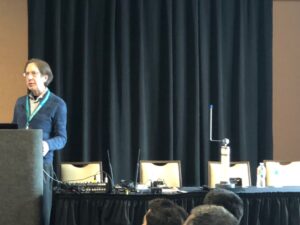
Professor Kaiser then took the stage to talk about his new curriculum on motor control by first explaining how universities traditionally approach this subject. Despite the ubiquity of control systems, students don’t get much hands-on experience, and the coursework mostly focuses on analog models, even though digital systems are highly popular. He then introduced his inverted rotary pendulum, a kit that costs less than a textbook. He also explained that the L6474 digital motor interface and the Nucleo board from ST offer the ability to introduce new control system problems, change models to perform instantaneous experiments, and build compelling control systems. The adjustability of the course surprised the audience because by changing a few parameters, or the position of the pendulum’s weight, teachers can offer students an entirely different problem instead of having everyone in the class work on the same solution.
The Audience on the Control System Curriculum
The audience’s response was so positive that one of the first questions was about the accessibility of the teaching material. There will be tutorials online, and they will lighten the educator’s burden. The cost-effectiveness of the kit also makes it extremely accessible, and even if the talk at ASEE showcased a real-time viewer on MATLAB, a license is not a requirement, meaning that it’s possible to keep the monetary investment to a minimum. In fact, the undergraduates who see the pendulum often express a desire to join the course because of how approachable it is. The presence of the ST boards means that teachers can tailor the content to multiple engineering fields, bringing motor control and embedded systems to more disciplines. Teachers can use the pendulum in a down position (suspended) to cover stable systems for entry-level students or offer advanced mechatronics and non-linear control challenges for graduate students.
We will update this blog post once the inverted rotary pendulum kit is available for purchase.
- A Hands-On, Open, Configurable and Low-Cost Platform for Engineering Control Systems Education (Slides)
Professor Kaiser on the SensorTile with Embedded Machine Learning Curriculum
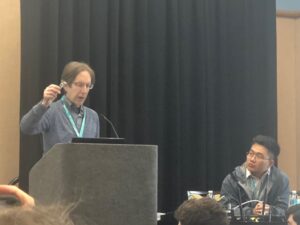
Finally, the last talk on embedded machine learning started with an overview of the Introduction to Embedded Sytems with SensorTile curriculum and its impact on UCLA. Half of the freshmen taking this course don’t have previous programming experience, and UCLA is looking to vastly increase the number of students taking it. Nevertheless, it was probably Professor Kaiser’s students that ultimately stole the show. Learning about Charles Zaloom, a graduate of this course, develop Embedded Machine Learning and listening to Professor Kaiser delve into his student’s complex optimizations, was mind-bending. Watching undergraduates train a neural network to detect the characteristics of a free throw motion was impressive. Hearing Xu Zhang’s experience as he now teaches the course was the best testimony of the inspiration students get when they can own a sensor module like the SensorTile and take a course that gives them unparalleled experience in machine learning.
The Audience on the SensorTile with Embedded Machine Learning Curriculum
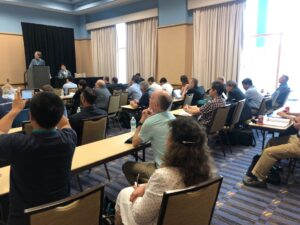
The first question from the audience was about the price of a SensorTile kit and the ways people could get the module and the tutorials, which is the best testament to the enthusiasm that overtook the crowd. Professor Kaiser answered inquiries about the content itself, such as the way the tutorials approach Bluetooth Low Energy, the ability to connect to a cloud infrastructure from IBM or others, and the access to the source code and documentation of the capstone’s designs. Xu also answered questions about his work on the BeagleBone and the code he wrote to enable the transfer of data from the SensorTile to the Linux platform over Bluetooth. The ability to introduce machine learning to first-year students that just grasped embedded systems, although it was a concept professional engineers didn’t begin to comprehend just a few years ago, truly marks a new beginning for universities.
